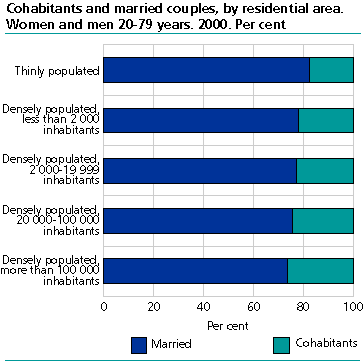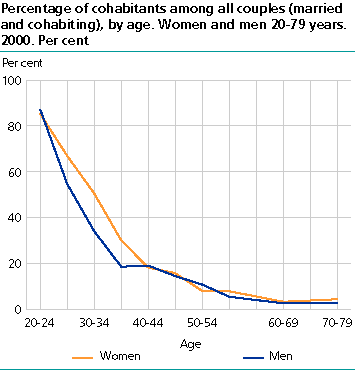Content
Published:
This is an archived release.
Stable numbers of cohabitants
In 2000, 15 per cent of people aged 20-79 were cohabitants. The percentage of cohabitants remained at about this level throughout the last half of the 1990s. In the same age group 51 per cent are married, while 34 per cent do not live with a cohabitant or spouse.
Cohabitation is still most widespread among young people. In the age group 20-34 years, 30 per cent are cohabitants compared with 12 per cent of those aged 35-59. The occurrence of cohabitants among the elderly (60-79) is modest, only 2 per cent.
Most cohabitants in the Nordic countries
Cohabitation is more widespread in Norway than in most other countries. For a long time, Norway lagged behind Sweden and Denmark, but now the differences have largely been erased. Cohabitation is also common in many Central European countries such as France, Switzerland and the Netherlands, although it is not quite as common as in the Nordic countries. The combination of cohabitation and children is found more frequently in the Nordic countries. The percentage of children born out of wedlock is an indication of this. In Switzerland and the Netherlands, 10 and 23 per cent respectively were born out of wedlock in 1999, while in Norway the figure was 49 per cent. Cohabitation is still extremely rare in the southern European countries.
More cohabiting than married couples under 35 years of age
Another way of calculating the percentage of cohabiting couples is to exclude those not living as a couple, counting only the cohabitants among those couples who are married or cohabiting. Measured in this way, nearly one in four couples is a cohabitant relationship. There is a small majority of cohabitants (54 per cent) among those aged 20-34, while in the age group 35-59 married couples are in the majority and only 15 per cent are cohabitants. Among couples aged 60 and up cohabitants are far and few between, only 3 per cent are cohabitants and 97 per cent are married.
Marriage and cohabitation patterns are different for men and women in the younger age groups. This is because women start to cohabit and marry at younger ages. Average age of female cohabitants is 33.1 versus 35.5 years for men.
Somewhat fewer cohabitants in thinly populated areas
A comparison of thinly populated and densely populated areas shows that the percentage of cohabitants is somewhat lower in sparsely populated areas. In densely populated areas the percentage of cohabitants increases with the population. All in all, however, the differences are small. The figures for cohabitants are based on annual interview surveys. The size and composition of the samples make it impossible to produce statistics for municipalities and counties.
Contact
-
Ane Margrete Tømmerås
E-mail: ane.tommeras@ssb.no
tel.: (+47) 91 99 29 62
-
Anders Sønstebø
E-mail: anders.sonstebo@ssb.no
tel.: (+47) 46 66 37 74
-
Statistics Norway's Information Centre
E-mail: informasjon@ssb.no
tel.: (+47) 21 09 46 42


